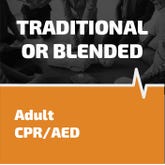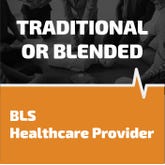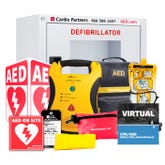(Almost) Everything You Need to Know About CPR and AEDs
- Dec 18, 2017

What is CPR? What Are AEDs? We Have the Answers!
Because it’s impossible to teach you everything you need to know about CPR and AEDs in the space of a blog, we’re happy to share the top 10 things you need to know about the life-saving procedure and device. For everything you need to know, sign up for a CPR and AED training class today!
5 Things You Need to Know About CPR:
What is CPR?
CPR, or cardiopulmonary resuscitation, is an easy-to-learn first aid technique that can keep the victims of a sudden cardiac arrest (SCA) or another medical emergency alive until medical professionals can take over.
What Does CPR Do?
CPR keeps blood pumping through the body, which helps maintain vital organ function. CPR has two primary goals: to keep oxygen flowing in and out of the lungs and to keep oxygenated blood flowing throughout the entire body.
Anyone Can Learn CPR
Although real-life doctors (and the actors who just play them on TV) perform CPR professionally, CPR training is easy and anyone can do it. With more than 350,000 cardiac arrests occurring each and every year, amateurs are welcome!
In many instances, “blended” courses allow busy folks to complete the text-based portion of the course online at their own pace and convenience. Once you’ve passed the online course, a focused 3-4 hour hands-on skills workshop rounds out the training. Wondering what you’ll learn in a CPR or First Aid class? Read our post on the subject!
CPR Can Be Tiring
Performing CPR can be physically demanding. High-performing CPR requires 100-120 deep and steady compressions per minute, so head to the gym and start working on your upper body strength and cardio! Take AED.com CPR playlist with you, while you’re at it! Should you be called upon to perform CPR in an emergency, you may find yourself getting tired, so if possible switch off with another person every couple of minutes.
Hands-Only CPR is Effective
Hands-only CPR (also known as compression-only CPR) is CPR without rescue breaths. The American Heart Association has noted that “Hands-only CPR carried out by a bystander has been shown to be as effective as CPR with breaths in the first few minutes during an out-of-hospital sudden cardiac arrest for an adult victim.”
5 Things You Need to Know About AEDs:
What is an AED?
An automated external defibrillator (AED) is a small, portable medical device. When its pads are attached to a person’s chest, the AED can analyze an individual’s heart rhythm and deliver a shock, if necessary, to restart his or her heart. Bystanders, as well as medical professionals, can use AEDs.
How Does an AED Work?
The device works by measuring an unresponsive person’s heart rhythm and delivering a shock to restart the heart or to shock the heart back into the correct rhythm. After analyzing the heart rhythm, automated voice instructions and text prompts tell the rescuer how to proceed. If defibrillation is necessary, the device will warn responders to stay clear of the victim while the shock is delivered. If CPR is indicated, the AED will instruct the rescuer to continue performing CPR.
When Do I Use an AED?
Sudden cardiac arrest can occur anytime, anywhere, and without warning. Call 911 and get the AED if someone becomes suddenly unresponsive, stops breathing, or does not respond when you tap or shake the shoulder firmly and ask, “Are you OK?”
Where Can I Find an AED?
Although laws for the placement of AEDs vary, many states require AEDs in public areas like gyms, schools, sports stadiums, and community centers. AEDs should be kept in a well-marked and publicly accessible location. If you don’t know where your office or workplace keeps the AED, find out! You never know when you might be called upon to use it.
If AEDs Are So Easy To Use, Why Do I Need Training?
Not only will training teach you how to respond quickly in the event of a cardiac emergency, but you’ll also learn how to activate the EMS system and act with confidence. Training also provides hands-on familiarity with an AED and teaches you how to avoid potentially dangerous situations.
For the full scoop on purchasing an AED, CPR and AED Training, and AED Compliance Management, download our free AED Starters Guide. Have questions? We’d love to chat! Call Cardio Partners at 800-544-0004. You can also email us at customerservice@cardiopartners.com.









 CALL US:
CALL US: